DEMS - Differential Electrochemical Mass Spectrometry compared to our EC-MS
DEMS VS. EC-MS COMPARISON
Are you considering to buy a Differential Electrochemical Mass Spectrometry – also called DEMS? Maybe you should consider buying the EC-MS from Spectro Inlets instead. It has several advantages that we try to explain below.
DEMS - Differential Electrochemical Mass Spectrometry?
EC-MS from Spectro Inlets
- Not compatible with volatile electrolytes
- Loss of analyte to differential 99% loss of product
- High consumption of electrolytes
- Not fully quantitative
- No data analysis program
- Time-consuming data analysis i.e. synchronization
- Fully compatible with volatile electrolytes
- Very low analyte loss and 100% collection efficiency
- Very low electrolyte consumption (very small sample volume)
- Embedded electronics and software synchronization
- Automatic and fast data analysis
- Uses a microchip technology to couple EC to MS
- No differential pumping
- 3 orders of magnitude more sensitive
- Time resolved
- Non-aqueous as well
- Fully quantitative
CONVENIENCE
The Spectro Inlets EC-MS is made by electrochemists for electrochemists, focusing on making quantitative mass spectrometry measurements of reaction products easily accessible for electrochemists. DEMS systems, Differential Electrochemical Mass Spectrometry, are most often homemade and require greater time and money resources while not guaranteeing reproducibility and accuracy and denying the possibility of quantitative measurements. Also, DEMS systems are not well documented, making training new students a big challenge.
SENSITIVITY
The Spectro Inlets EC-MS enables sub-turnover resolution for gaseous analytes with 100% collection efficiency and complete and fast control of dissolved gases at the working electrode. In conventional DEMS, the flux of molecules entering the MS is too large. Thus, a differential pumping system is needed. In the differential pumping stage, a significant fraction of the molecules to be analyzed is lost. Due to the loss of molecules, sensitivity is dramatically reduced, and signal quantification becomes impossible.
REPRODUCIBILITY
Our membrane chip technology is precisely defined by the accurate microfabrication process, whereas typical porous Teflon DEMS membranes exhibit immense variability by nature. As a result, the Spectro Inlets EC-MS offers maximum reproducibility by having a well-defined flux of molecules and a robust inert membrane surface.
SAFETY
The Spectro Inlets membrane microchip protects the mass spectrometer from inadvertent vacuum failures. On the contrary, DEMS membranes are susceptible to failure, challenging to exchange, and often result in irreproducible results.
ELECTROLYTE SATURATION
The Spectro Inlets EC-MS cell is designed to provide rapid and facile electrolyte saturation through our gas exchange system. In DEMS, a saturation of the electrolyte is impractical, slow, and necessitates extra equipment such as an external electrolyte reservoir, a bubbler, and a pump.
QUANTIFICATION
The stagnant thin-layer EC-cell and the absence of differential pumping allow for 100% collection efficiency of the reaction products and make it possible to quantify submonolayer concentrations. The high-water evaporation rate in differentially pumped DEMS necessitates operation in flow mode, whereby most of the reaction products are lost in the flow, and another large fraction is lost to differential pumping.
TIME RESOLUTION
The Spectro Inlets EC-MS provides a fully defined geometry for transporting reaction products to the mass spectrometer. Time resolution in DEMS is obtained at the expense of collection efficiency, whereas the Spectro Inlets EC-MS locks both parameters with no compromise and full accuracy.
As a result, with DEMS, it is impossible to measure small product amounts with decent time resolution. In contrast, EC-MS is specifically built to allow submonolayer sensitivity with subsecond time resolution.
STANDARDIZED SAMPLE HOLDER
The Spectro Inlets EC-MS sample holder mounts standard 5 mm rotating disk electrodes (RDE) available off-the-shelf by PINE research instruments – PINE research instruments. Besides, it allows using any type and size of the counter and reference electrodes. In DEMS, the choice of working, counter, and reference electrodes is dependent on the cell geometry and often requires expensively manufactured electrodes to be custom-manufactured.
DYNAMIC RANGE
The Spectro Inlets EC-MS enables resolving concentrations of any volatile dissolved species from saturation concentration to 6 orders of magnitude (one millionth) less than that.
DEMS is not optimized for a dynamic range of volatile products, restricted instead to the capabilities of the differential pump, and therefore sacrificing signal-to-noise and signal-to-background.
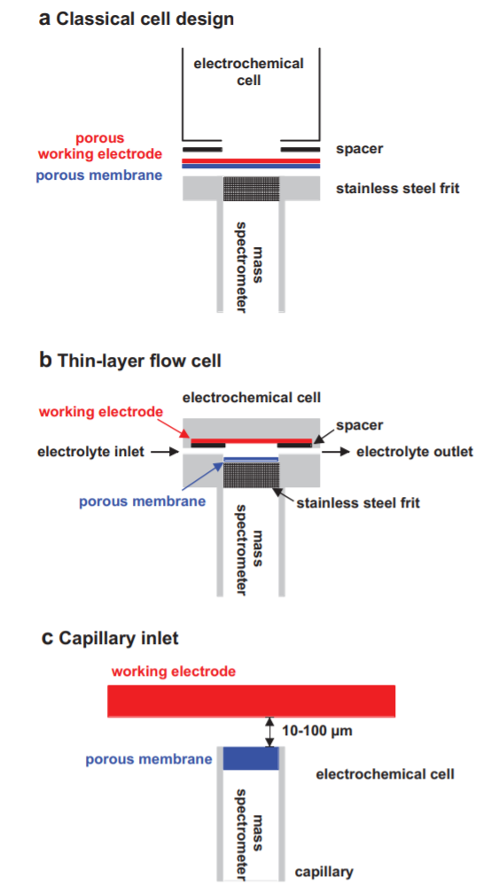
Different types of classical DEMS inlets.
Mass Spectrom. Rev. 34, 64–92 (2015).
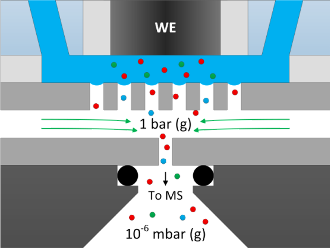
Schematic representation of the unique Spectro Inlets
EC-MS microchip-based inlet.
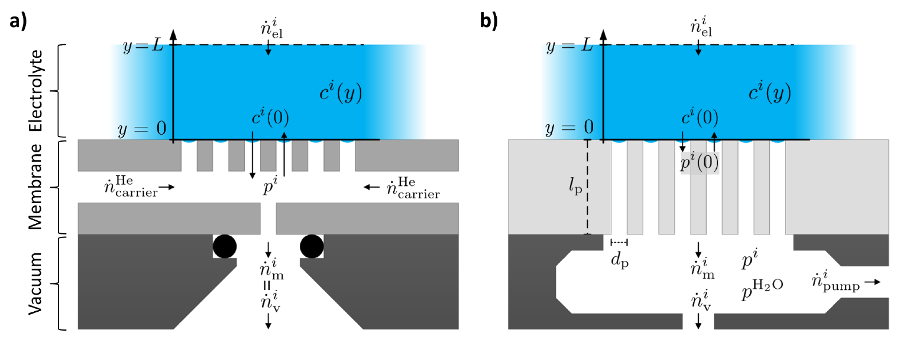
Schematic diagrams showing transport of an analyte i at two types of liquid – vacuum inlet systems – DOI
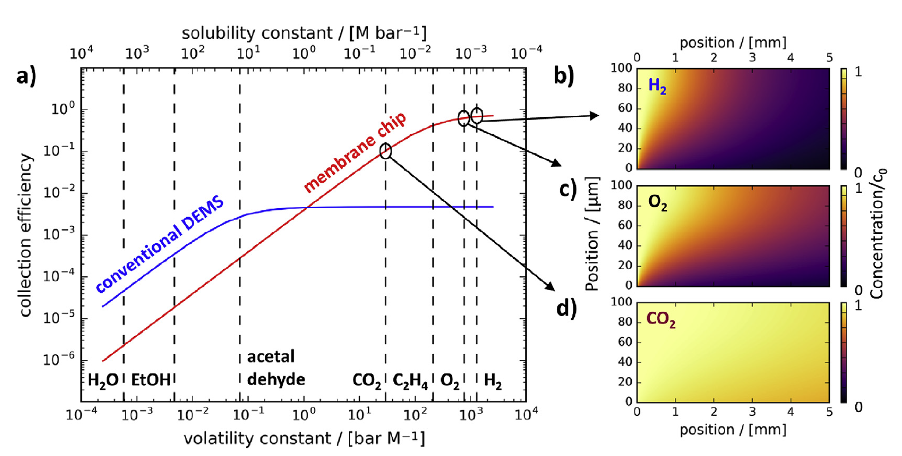
Chip-based vs differentially pumped EC-MS.
Model comparison of chip-based and differentially pumped electrochemistry – mass spectrometry in a flow system at steady state – DOI
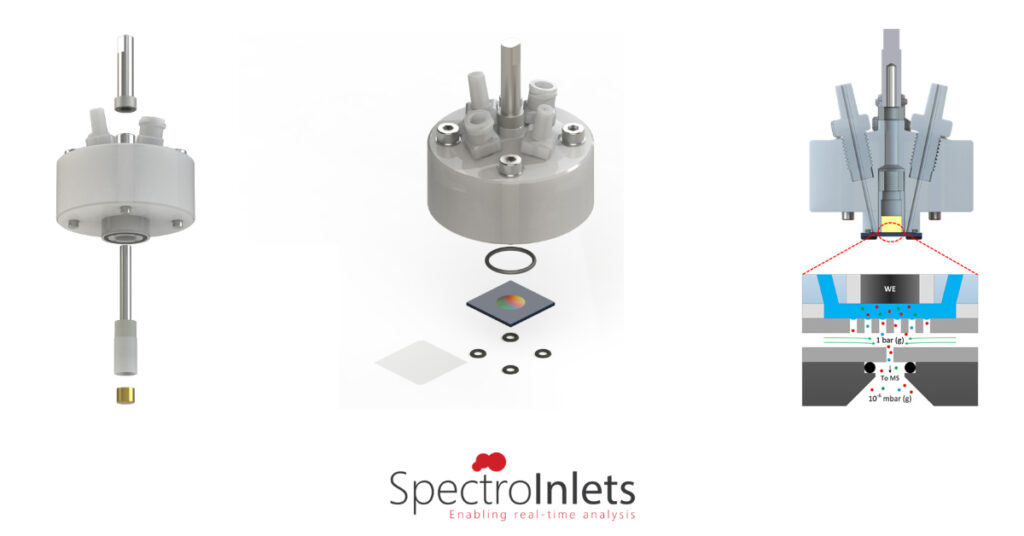
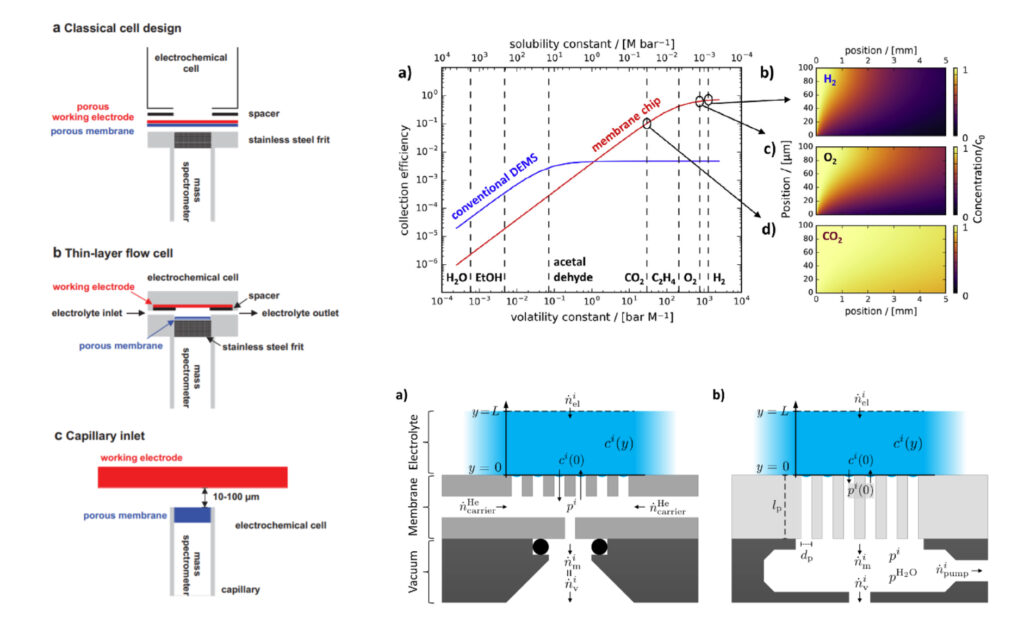
Interested?
Do not hesitate to contact us for a quotation or a talk and presentation of our product
